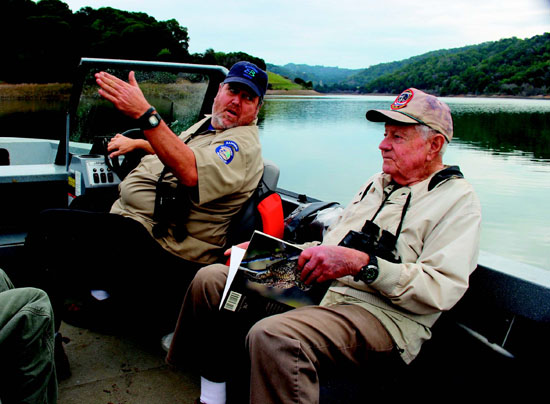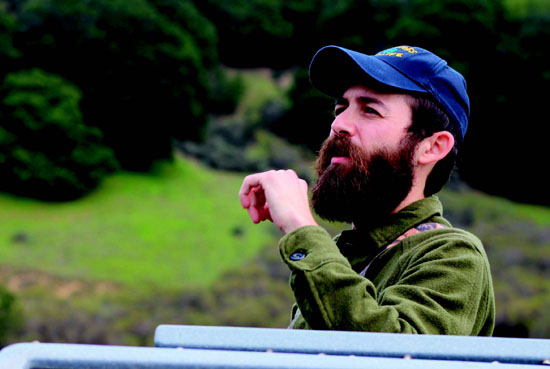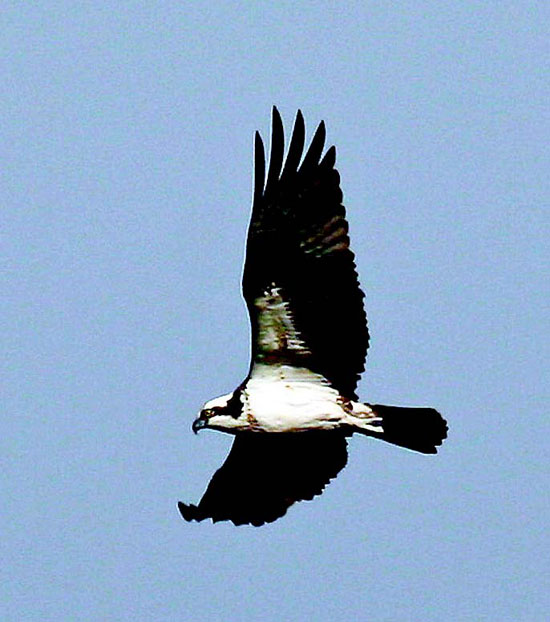 |
|
|
Mark Silva and Bill Swearingen discuss what they saw the previous year. Photo Chris Lavin
|
|
|
|
|
|
Tooling around Lamorinda on any given day, one might stop and see a bigger bird than usual perched atop a power line, a telephone pole or at the apex of a big tree. If it's not a crow or a raven, it's most likely a raptor. In our area, that usually means identifying one of roughly 24 species, not counting the various kinds of owls.
 "Raptors are not hard to spot," said Bill Swearingen, a lifelong master falconer in Bollinger Canyon who has kept the winged hunters off and on at his Lafayette home. Swearingen is modest. On a hike in the middle of a valley he can spot what looks like a pimple on a power pole a quarter-mile out. "There's a young golden eagle," he will say, and sure enough, the holder of good binoculars will say that yes, indeed, that is a golden eagle.
"Raptors are not hard to spot," said Bill Swearingen, a lifelong master falconer in Bollinger Canyon who has kept the winged hunters off and on at his Lafayette home. Swearingen is modest. On a hike in the middle of a valley he can spot what looks like a pimple on a power pole a quarter-mile out. "There's a young golden eagle," he will say, and sure enough, the holder of good binoculars will say that yes, indeed, that is a golden eagle.
 In an effort to keep tabs on the raptor population, the East Bay Municipal Utility District conducts an annual "eagle count," and tallies other raptors, too. Manned with a multitude of count sheets and graphs in a manila folder, a team from EBMUD went out one day in January to record what they saw around Briones Reservoir. Other teams handled the other reservoirs in the local watershed, including San Pablo, Lafayette and San Leandro.
In an effort to keep tabs on the raptor population, the East Bay Municipal Utility District conducts an annual "eagle count," and tallies other raptors, too. Manned with a multitude of count sheets and graphs in a manila folder, a team from EBMUD went out one day in January to record what they saw around Briones Reservoir. Other teams handled the other reservoirs in the local watershed, including San Pablo, Lafayette and San Leandro.
 Swearingen was part of the team. "I don't know why they do the survey at this time of year," he said. "It's not the best time to see eagles, or anything else." He turned out to be right: After a three-hour Gilligan's Island tour of Briones, the results were disappointing. At the end of the day: one osprey, one red-tailed hawk. Zero eagles.
Swearingen was part of the team. "I don't know why they do the survey at this time of year," he said. "It's not the best time to see eagles, or anything else." He turned out to be right: After a three-hour Gilligan's Island tour of Briones, the results were disappointing. At the end of the day: one osprey, one red-tailed hawk. Zero eagles.
 Needless to say, it didn't take long to fill out the paperwork.
Needless to say, it didn't take long to fill out the paperwork.
 "Last year we saw goldens (golden eagles), otters, and all kinds of wildlife," Swearingen said. Briones hosts a healthy population of otters, it turns out. After the cruise, taken on a balmy and sunny day, the attending EBMUD biologist was asked if he was worried about the lack of sightings.
"Last year we saw goldens (golden eagles), otters, and all kinds of wildlife," Swearingen said. Briones hosts a healthy population of otters, it turns out. After the cruise, taken on a balmy and sunny day, the attending EBMUD biologist was asked if he was worried about the lack of sightings.
 "Not at all," said Jonathan Price, who works out of the office off San Pablo Dam Road. "We see the populations. They're good."
"Not at all," said Jonathan Price, who works out of the office off San Pablo Dam Road. "We see the populations. They're good."
 Survey results were submitted to the California Department of Fish and Game in Sacramento, where the office is still calculating the results from similar surveys throughout the state. Results should be available in March, when the raptor population is more active and another survey is planned.
Survey results were submitted to the California Department of Fish and Game in Sacramento, where the office is still calculating the results from similar surveys throughout the state. Results should be available in March, when the raptor population is more active and another survey is planned.
 Throughout the Lamorinda watershed, it's not uncommon to see more than a dozen different raptors. "Most often, you're going to see either a turkey vulture or a red-tailed hawk, nine times out of ten," Swearingen said. But kestrels are also common, as are Cooper's, sharp-shinned and red-shouldered hawks. "And merlins. Merlins migrate through here, but if there's food, they'll stick around," said Swearingen. Add to that rough-legged hawks, and even the occasional peregrine, and you've got yourself a menagerie.
Throughout the Lamorinda watershed, it's not uncommon to see more than a dozen different raptors. "Most often, you're going to see either a turkey vulture or a red-tailed hawk, nine times out of ten," Swearingen said. But kestrels are also common, as are Cooper's, sharp-shinned and red-shouldered hawks. "And merlins. Merlins migrate through here, but if there's food, they'll stick around," said Swearingen. Add to that rough-legged hawks, and even the occasional peregrine, and you've got yourself a menagerie.
 "What we missed were the goldens," Swearingen said after getting off the boat. One pair of golden eagles has been known to nest at Briones for several years, and fledglings have been documented taking flight and moving elsewhere over the course of the last decade. "We don't know where (the fledglings went) but I'm sure it's nearby. It depends on the food supply." Indeed, a few days after the official survey, bald eagles, several ospreys and multiple red-tailed hawks were sighted at San Pablo Reservoir, just a few miles off.
"What we missed were the goldens," Swearingen said after getting off the boat. One pair of golden eagles has been known to nest at Briones for several years, and fledglings have been documented taking flight and moving elsewhere over the course of the last decade. "We don't know where (the fledglings went) but I'm sure it's nearby. It depends on the food supply." Indeed, a few days after the official survey, bald eagles, several ospreys and multiple red-tailed hawks were sighted at San Pablo Reservoir, just a few miles off.
 After the official survey in January, EBMUD Supervisor Scott Hill ran into one of the spotting team in the parking lot. "What did you see?" he asked.
After the official survey in January, EBMUD Supervisor Scott Hill ran into one of the spotting team in the parking lot. "What did you see?" he asked.
 "One osprey," she said.
"One osprey," she said.
 "That's probably the same osprey they saw on San Pablo," Hill said. "They must be keeping a low profile."
"That's probably the same osprey they saw on San Pablo," Hill said. "They must be keeping a low profile."

|


